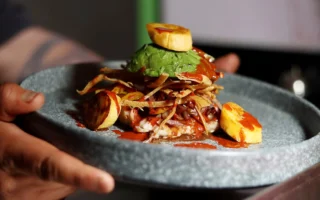The word “chiñindrina” carries deep cultural and culinary connotations within Mexican society, particularly in the northern regions. Although its origins are somewhat obscure, it is a term that encapsulates both food and folklore. To understand the significance of the “chiñindrina,” we must explore its historical context, cultural importance, and its place in contemporary Mexican cuisine.
Origins of the Word “Chiñindrina”
“Chiñindrina” is believed to be a colloquial word, primarily used in the northern parts of Mexico, such as Chihuahua. It is often associated with street food, which forms an integral part of Mexican food culture. Though it may not appear in formal dictionaries or linguistic studies, “chiñindrina” is widely recognized among locals as a reference to a specific type of Mexican snack or an object with a traditional feel.
The term itself carries a playful or informal tone, which is typical of how many Spanish dialects in Mexico evolve. It’s common for words to take on a new identity depending on the region or even the town, with some phrases or slang having no formal roots but instead existing purely within the lived experiences of those who use them.
The Chiñindrina in Mexican Street Food
In the world of Mexican street food, the “chiñindrina” refers to a unique and savoury treat. It is essentially a large pork skin tostada, or chicharrón, that is topped with an array of delicious ingredients. The base, a crisp chicharrón, serves as the perfect canvas for the rich toppings that vary from region to region but often include shredded cabbage, tomatoes, avocado, jalapeños, and crumbled cheese. The combination of these ingredients creates a delightful balance of textures and flavours, from the crunch of the pork skin to the creamy smoothness of the avocado.
What makes the chiñindrina stand out is the versatility of the dish. It can be enjoyed as a quick snack on the go or as a larger meal, depending on the portion size and the toppings added. Street vendors, especially in cities like Ciudad Juárez and Chihuahua, have popularised the dish, turning it into a local favourite.
The Ritual of Eating a Chiñindrina
Eating a chiñindrina is not just about the flavours; it’s about the experience. Like many street foods, it is best enjoyed standing up, perhaps at a food stall surrounded by other locals. The atmosphere contributes to the enjoyment of the dish, making it a communal experience. The messiness of eating a chiñindrina adds to the charm—toppings might spill over the sides, and the crunch of the pork skin can be heard with each bite.
One of the defining characteristics of the chiñindrina is the flexibility it offers. You can customise it based on your preferences, adding more spicy salsas for a kick or opting for milder toppings for a more subtle flavour. This adaptability ensures that no two chiñindrinas are exactly alike, allowing for a personalised dining experience each time.
Chiñindrina: A Symbol of Northern Mexican Identity
The chiñindrina is more than just a tasty dish; it represents a slice of northern Mexican identity. In states like Chihuahua, where the dish is particularly popular, it has become a culinary emblem, showcasing the region’s ability to transform simple ingredients into something extraordinary.
The dish’s rustic nature speaks to the history of the region, where resourcefulness and creativity have long been key traits in food preparation. Pork skin, a humble ingredient, is elevated into something worthy of celebration when it becomes the base of the chiñindrina. This mirrors the larger theme in Mexican cuisine, where basic ingredients such as maize, beans, and peppers are transformed into iconic dishes.
Modern Takes on the Chiñindrina
Though the traditional chiñindrina remains beloved by many, modern variations have started to emerge. Some street vendors have begun experimenting with the toppings, adding ingredients like grilled meats, exotic cheeses, or even seafood. These modern twists add new dimensions to the already dynamic dish, appealing to a broader audience and ensuring that the chiñindrina continues to evolve with the times.
Additionally, some restaurants have started to offer chiñindrinas as part of their menu, elevating the street food favourite into a gourmet item. The rise of fusion cuisine has also seen chiñindrinas adapted in creative ways, blending elements from other culinary traditions with the classic Mexican flavours.
Conclusion
The chiñindrina stands as a testament to the richness of Mexican street food culture and the ability of simple ingredients to create something deliciously unique. While it may be a dish with humble origins, its impact on the culinary landscape, especially in northern Mexico, is undeniable. For anyone visiting the region, trying a chiñindrina is a must, not just to taste the flavours but to connect with the cultural heritage it represents.
As the dish continues to evolve and find its way into new kitchens and menus, the chiñindrina will undoubtedly remain a beloved staple of Mexican street food. Whether enjoyed as a quick snack or a full meal, its crunchy, savoury goodness offers a bite-sized reflection of Mexico’s vibrant and ever-adapting culinary tradition.



